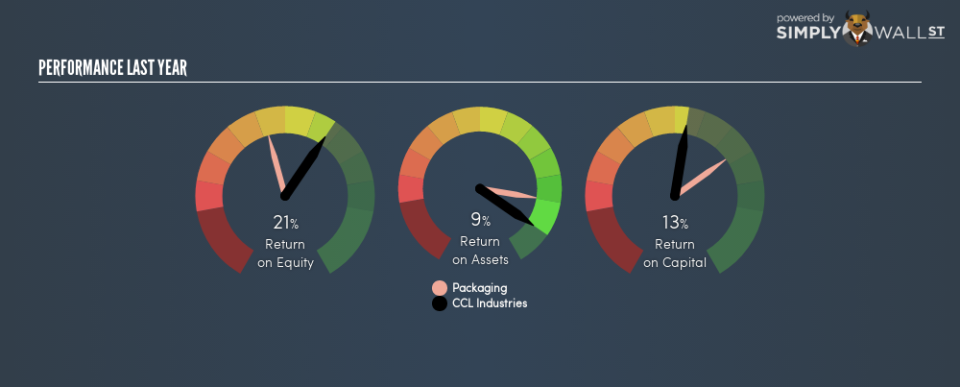Here’s What CCL Industries Inc.’s (TSE:CCL.B) Return On Capital Can Tell Us

Want to participate in a short research study? Help shape the future of investing tools and you could win a $250 gift card!
Today we’ll evaluate CCL Industries Inc. (TSE:CCL.B) to determine whether it could have potential as an investment idea. Specifically, we’ll consider its Return On Capital Employed (ROCE), since that will give us an insight into how efficiently the business can generate profits from the capital it requires.
First, we’ll go over how we calculate ROCE. Next, we’ll compare it to others in its industry. Then we’ll determine how its current liabilities are affecting its ROCE.
What is Return On Capital Employed (ROCE)?
ROCE is a metric for evaluating how much pre-tax income (in percentage terms) a company earns on the capital invested in its business. All else being equal, a better business will have a higher ROCE. Overall, it is a valuable metric that has its flaws. Author Edwin Whiting says to be careful when comparing the ROCE of different businesses, since ‘No two businesses are exactly alike.’
How Do You Calculate Return On Capital Employed?
Analysts use this formula to calculate return on capital employed:
Return on Capital Employed = Earnings Before Interest and Tax (EBIT) ÷ (Total Assets – Current Liabilities)
Or for CCL Industries:
0.13 = CA$677m ÷ (CA$6.7b – CA$1.2b) (Based on the trailing twelve months to September 2018.)
So, CCL Industries has an ROCE of 13%.
View our latest analysis for CCL Industries
Is CCL Industries’s ROCE Good?
ROCE is commonly used for comparing the performance of similar businesses. We can see CCL Industries’s ROCE is around the 12% average reported by the Packaging industry. Separate from CCL Industries’s performance relative to its industry, its ROCE in absolute terms looks satisfactory, and it may be worth researching in more depth.
CCL Industries’s current ROCE of 13% is lower than its ROCE in the past, which was 19%, 3 years ago. Therefore we wonder if the company is facing new headwinds.
It is important to remember that ROCE shows past performance, and is not necessarily predictive. ROCE can be misleading for companies in cyclical industries, with returns looking impressive during the boom times, but very weak during the busts. ROCE is only a point-in-time measure. Since the future is so important for investors, you should check out our free report on analyst forecasts for CCL Industries.
What Are Current Liabilities, And How Do They Affect CCL Industries’s ROCE?
Current liabilities include invoices, such as supplier payments, short-term debt, or a tax bill, that need to be paid within 12 months. Due to the way ROCE is calculated, a high level of current liabilities makes a company look as though it has less capital employed, and thus can (sometimes unfairly) boost the ROCE. To check the impact of this, we calculate if a company has high current liabilities relative to its total assets.
CCL Industries has total liabilities of CA$1.2b and total assets of CA$6.7b. As a result, its current liabilities are equal to approximately 18% of its total assets. Current liabilities are minimal, limiting the impact on ROCE.
The Bottom Line On CCL Industries’s ROCE
This is good to see, and with a sound ROCE, CCL Industries could be worth a closer look. Of course you might be able to find a better stock than CCL Industries. So you may wish to see this free collection of other companies that have grown earnings strongly.
For those who like to find winning investments this free list of growing companies with recent insider purchasing, could be just the ticket.
To help readers see past the short term volatility of the financial market, we aim to bring you a long-term focused research analysis purely driven by fundamental data. Note that our analysis does not factor in the latest price-sensitive company announcements.
The author is an independent contributor and at the time of publication had no position in the stocks mentioned. For errors that warrant correction please contact the editor at editorial-team@simplywallst.com.

 Yahoo Finance
Yahoo Finance 
